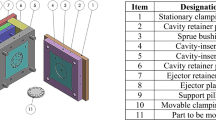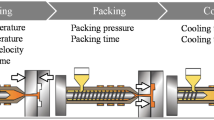Abstract
Different settings of process parameters in injection molding can directly influence the internal residual stress of injection parts, while to a certain degree, the internal residual stress field will, in turn, affect the performance of parts during assembly and service process. Therefore, for most parts which will be subjected to external loads as part of a system, it has practical significance to improve their performance through integration optimization of molding and service. In this paper, the service of a molded part is divided into three stages: molding, assembly, and service, and an integration model is built for optimizing its service performance, considering all these three stages. A sequential optimization algorithm based on kriging surrogate model and expected improvement sampling criteria is used to perform the optimization analysis on polycarbonate material parts. Results show that the integration optimization strategy proposed in this paper can decrease the maximum service stress effectively. Furthermore, the non-assembly and non-load carrying parts are also considered and the stresses are optimized. Comparison among these three situations shows that integration optimization is essential when service performance is considered for the molded parts.
Similar content being viewed by others
References
Zhao J, Cheng G, Ruan S, Li Z (2015) Multi-objective optimization design of injection molding process parameters based on the improved efficient global optimization algorithm and non-dominated sorting-based genetic algorithm. Int J Adv Manuf Technol 78(9-12):1813–1826
Xia W, Luo B, Liao X (2011) An enhanced optimization approach based on Gaussian process surrogate model for process control in injection molding. Int J Adv Manuf Technol 56(9-12):929–942
Zhao P, Zhou H, Li Y, Li D (2010) Process parameters optimization of injection molding using a fast strip analysis as a surrogate model. Int J Adv Manuf Technol 49(9-12):949–959
Xu G, Yang Z (2015) Multiobjective optimization of process parameters for plastic injection molding via soft computing and grey correlation analysis. Int J Adv Manuf Technol 78(1-4):525–536
Shie JR (2008) Optimization of injection molding process for contour distortions of polypropylene composite components by a radial basis neural network. Int J Adv Manuf Technol 36(11-12):1091–1103
Shi H, Gao Y, Wang X (2010) Optimization of injection molding process parameters using integrated artificial neural network model and expected improvement function method. Int J Adv Manuf Technol 48(9-12):955–962
Dang XP (2014) General frameworks for optimization of plastic injection molding process parameters. Simul Model Pract Theory 41:15–27
Lee BH, Kim BH (1995) Optimization of part wall thicknesses to reduce warpage of injection-molded parts based on the modified complex method. Polym-Plast Technol Eng 34(5):793–811
Kurtaran H, Erzurumlu T (2006) Efficient warpage optimization of thin shell plastic parts using response surface methodology and genetic algorithm. Int J Adv Manuf Technol 27(5-6):468–472
Ozcelik B, Erzurumlu T (2006) Comparison of the warpage optimization in the plastic injection molding using ANOVA, neural network model and genetic algorithm. J Mater Process Technol 171(3):437–445
Zhou J, Turng LS (2007) Process optimization of injection molding using an adaptive surrogate model with Gaussian process approach. Polym Eng Sci 47(5):684–694
Shen C, Wang L, Li Q (2007) Optimization of injection molding process parameters using combination of artificial neural network and genetic algorithm method. J Mater Process Technol 183(2):412–418
Gao Y, Wang X (2008) An effective warpage optimization method in injection molding based on the kriging model. Int J Adv Manuf Technol 37(9-10):953–960
Kitayama S, Onuki R, Yamazaki K (2014) Warpage reduction with variable pressure profile in plastic injection molding via sequential approximate optimization. Int J Adv Manuf Technol 72(5-8):827–838
Mathivanan D, Parthasarathy NS (2009) Sink-mark minimization in injection molding through response surface regression modeling and genetic algorithm. Int J Adv Manuf Technol 45(9-10):867–874
Guo W, Hua L, Mao H (2014) Minimization of sink mark depth in injection-molded thermoplastic through design of experiments and genetic algorithm. Int J Adv Manuf Technol 72(1-4):365–375
Xu Y, Zhang QW, Zhang W, Zhang P (2015) Optimization of injection molding process parameters to improve the mechanical performance of polymer product against impact. Int J Adv Manuf Technol 76(9-12):2199–2208
Siegmann A, Kenig S, Buchman A (1987) Residual stresses in injection-molded amorphous polymers. Polym Eng Sci 27(14):1069–1078
Cao W, Shen C, Zhang C, Wang L (2008) Computing flow-induced stresses of injection molding based on the Phan–Thien–Tanner model. Arch Appl Mech 78(5):363–377
Isayev AI (1983) Orientation development in the injection molding of amorphous polymers. Polym Eng Sci 23(5):271–284
Zoetelief WF, Douven LFA, Housz AJ (1996) Residual thermal stresses in injection molded products. Polym Eng Sci 36(14):1886–1896
Simpson TW, Poplinski JD, Koch PN, Allen JK (2001) Metamodels for computer-based engineering design: survey and recommendations. Engineering with Computers 17(2):129–150
Matta A, Pezzoni M, Semeraro Q (2012) A kriging-based algorithm to optimize production systems approximated by analytical models. J Intell Manuf 23(3):587–597
Jouhaud JC, Sagaut P, Montagnac M, Laurenceau J (2007) A surrogate-model based multidisciplinary shape optimization method with application to a 2D subsonic airfoil. Comput Fluids 36(3):520–529
Gao Y, Wang X (2009) Surrogate-based process optimization for reducing warpage in injection molding. J Mater Process Technol 209(3):1302–1309
Wang X, Gu J, Shen C, Wang X (2014) Warpage optimization with dynamic injection molding technology and sequential optimization method. Int J Adv Manuf Technol 78:177–187
Cressie N (1990) The origins of kriging. Math Geol 22(3):239–252
Jones DR, Schonlau M, Welch WJ (1998) Efficient global optimization of expensive black-box functions. J Glob Optim 13(4):455–492
Sun F, Liu MQ, Lin DKJ (2010) Construction of orthogonal Latin hypercube designs with flexible run sizes. J Stat Plan Infer 140(11):3236–3242
Georgiou SD, Stylianou S (2011) Block-circulant matrices for constructing optimal Latin hypercube designs. J Stat Plan Infer 141(5):1933–1943
Author information
Authors and Affiliations
Corresponding author
Rights and permissions
About this article
Cite this article
Liu, W., Wang, X., Li, Z. et al. Integration optimization of molding and service for injection-molded product. Int J Adv Manuf Technol 84, 2019–2028 (2016). https://doi.org/10.1007/s00170-015-7862-z
Received:
Accepted:
Published:
Issue Date:
DOI: https://doi.org/10.1007/s00170-015-7862-z




